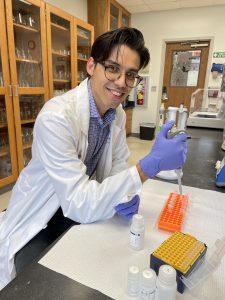
Ask John Santiago about beneficial soil microbes, and his eyes dazzle. He will tell you that scientists are about to uncover microbes that protect plants from disease. Santiago aspires to be one of the scientists who will make these breakthroughs.
Santiago is about to complete a Ph.D. in Horticultural Sciences, specializing in plant root biology. He aims to improve crop production with microbiology. Soil microbiology is about identifying microscopic organisms and examining interactions that these organisms share with different plant species, he said.
In the Plant Root Biology Laboratory at the UF/IFAS Indian River Research and Education Center (IRREC), Santiago investigates beneficial bacteria in soil samples he collects around citrus crop tree roots. He wears a starchy lab coat and extracts the bacteria and fungi DNA from his soil samples.
“My graduate research focuses on the rhizosphere, or the soil area surrounding plant roots. In the soil area, the trees are influenced by microbial and chemical interactions that impact growth, respiration, and nutrient exchange in the trees,” said Santiago.
“John Santiago’s work is for soils around citrus trees infected with a plant disease associated with an invasive insect,” said Lorenzo Rossi, assistant professor of plant root biology at IRREC. “Santiago studies citrus roots and their interactions with the soil microbial community. The insect is the Asian citrus psyllid.”
Because there is so much international trade and transportation available, insects that do not belong in Florida can get transported unintentionally. The psyllid is believed to have arrived in a crate of imported nursery plants in Fort Lauderdale, Florida, about 15 years ago. Today, all the citrus trees in Florida are infected with citrus greening, a disease that shortens the life of the trees and compromises the fruit they produce, said Santiago.
Santiago evaluates the rhizosphere after applying different soil treatments using the experimental and commercial trees. A first soil treatment involves fertilizers. The second application to the soil is a fabric mulch ground cover, or a layer of black plastic “mulch” across the area immediately under the trees. Groundcovers have been found to help soils retain moisture and reduce unwanted weeds around crop trees. Santiago’s third treatment for the experimental earth is hardwood oak mulch. Anecdotal reports made by heritage citrus growers are that citrus trees that stand within the dripline of oak trees do not become infected with citrus greening.

“The hypothesis is that more beneficial bacteria will be found in the soil where organic amendments were added,” Santiago said.
Microbiology is the field in which scientists learn to treat and prevent disease. The study of microbiology encompasses viruses, bacteria, protozoa, and fungi. Santiago explains what microbiology can do for people everywhere.
Santiago’s interests as a graduate student and researcher are specific to the soil that surrounds citrus tree roots. The first step in his work is to collect soil samples. His soil collection tools include a sterilized metal spade, brown paper bags, and alcohol to sterilize the spade each time a soil sample is collected. Every time.
“I collect and extract the DNA from soil and roots and later sequence the microbiome data,” said Santiago. “What that means is that I use specific instrumentations to identify microbes associated with beneficial functions to plant health and determine how their abundances differs across treatments. ”
He stores the bagged soil samples in a freezer—at minus 80 degrees Celsius. On a day when Santiago extracts DNA from the samples, he does so using various materials that include pipettes, a centrifuge, and reagents.
The following steps involve a nanodrop machine to quantify the quality of the extracted DNA. The DNA samples can also be plated onto an agarose gel matrix. The electrophoresis equipment applies an electric field to the agarose gel. He can see his work and the charged molecules on a screen that resemble white-light bars aligned next to each other. Some are shorter than others, depending on the quality of the DNA
“At this point, we send the DNA samples out for sequencing,” said Santiago. “Once the sequencing data returns, it is processed in our statistical analyses to determine significant differences in diversity, abundance, and health of the rhizosphere microbiome.”
Citrus was once Florida’s signature crop, with high-quality fresh fruit shipped as far away as Japan, where Indian River grapefruit is a delicacy for the Japanese, Koreans, and Europeans. Citrus offers growers and agricultural production regions high economic value and nutritious food for consumers, so efforts to save Florida’s crop are important to us, said Santiago.
“There is so much yet undiscovered in soils that could support food crops,” Santiago says. He smiles, and the look in his eyes is evident in amazement.
“There are a large quantity of soil microbes that scientists have yet to discover, notably those at the taxonomic levels of genus and species, that can have impacts on plant health,” said Santiago. “We believe beneficial bacteria exist in the soils that can help citrus trees uptake essential nutrients, even if the trees are diseased with citrus greening, which may be critical to fruit yield.”
 13
13
